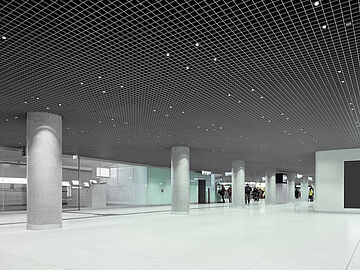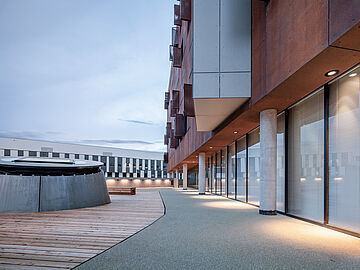Changi Airport
Changi daylight system – self-regulated daylight and artificial lighting system, comprising:
Overhead lights
made of daylight-deflecting reflective surfaces inside the terminals [919 units, 60,000m2 of parabolic panels]
Butterfly-Panels
made of anodized aluminium on the roof, activated electronically by a BUS system and that aligns their position in response to the angle of the sun and the brightness of the sky [919 units]
Artificial light 1000 W light projectors [90 units] on the roof, direct lights [919 units] under the butterfly panels, indirect lights [128 units] to light up the Check-In Counter and the areas of greenery; mirror spotlights in front of the terminal [300 units]
dur-TRONIC system
to control daylight and artificial light
A great deal of natural light and an unobstructed view of the outside world – that was the guiding notion of the airport operator when the decision was taken to implement its very special daylight solution. What began as an idea has grown into a sustainable reality: the remarkable and unusual design of Terminal 3 at Changi Airport in Singapore offers everything that travellers could wish for.
This was made possible by the organic-looking roof, extending over a surface area of about 9 hectares with more than 900 specially developed ceiling light wells, thousands of aluminium panels and a movable shading system from durlum. The ceiling light wells use aluminium reflectors to direct daylight into the building, providing uniform illumination without dazzling visitors.
The amount of light directed into Terminal 3 is determined by movable and perforated butterfly panels mounted above each light well. The position of these panels is guided by the angle of the sun, and by the prevailing daylight and weather situation. Sensors on the roof obtain the information required to control these butterfly panels and direct it to a central computer that runs the entire terminal. This enables daylight to enter the space without admitting any direct sunlight. In bad weather and at night, direct lighting takes over from sunlight: these lights are located on the roof below the butterfly panels. As sunlight levels diminish, this lighting is turned on, so gradually that passengers are not aware of the change. This means that artificial lighting and daylight make use of the same light deflection systems, and the heat from the radiant lamps remains outside the building. A total of about 2400 tons of CO2 have been saved.
This lighting system, planned by Bartenbach LichtLabor [Lighting Laboratory] and implemented by durlum, creates an atmosphere which visitors can enjoy, while at the same time reducing energy consumption and protecting the environment. It is therefore no surprise that Changi Airport in Singapore has been proving so popular with travellers for so many years.


